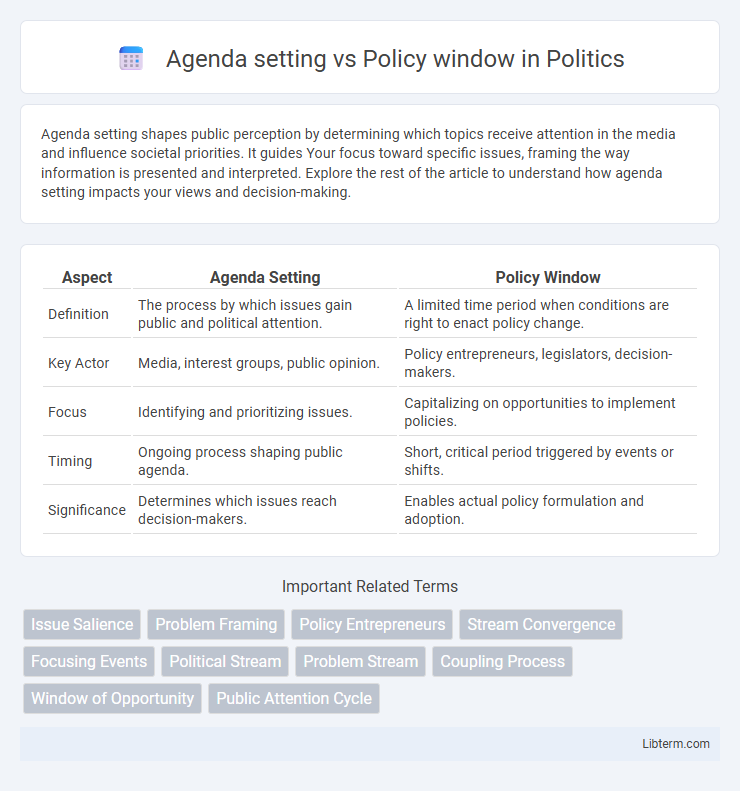Agenda setting shapes public perception by determining which topics receive attention in the media and influence societal priorities. It guides Your focus toward specific issues, framing the way information is presented and interpreted. Explore the rest of the article to understand how agenda setting impacts your views and decision-making.
Table of Comparison
| Aspect | Agenda Setting | Policy Window |
|---|---|---|
| Definition | The process by which issues gain public and political attention. | A limited time period when conditions are right to enact policy change. |
| Key Actor | Media, interest groups, public opinion. | Policy entrepreneurs, legislators, decision-makers. |
| Focus | Identifying and prioritizing issues. | Capitalizing on opportunities to implement policies. |
| Timing | Ongoing process shaping public agenda. | Short, critical period triggered by events or shifts. |
| Significance | Determines which issues reach decision-makers. | Enables actual policy formulation and adoption. |
Understanding Agenda Setting in Policy Making
Agenda setting in policy making involves identifying and prioritizing issues that require government attention, shaping the public and political discourse. The policy window concept refers to the opportune moments when these issues gain traction, allowing policymakers to push forward proposals. Understanding agenda setting helps explain how problems enter the political agenda and why some receive action while others remain unaddressed.
Defining the Policy Window Concept
The policy window concept refers to the limited time frame during which political conditions align to enable the adoption of a particular policy proposal. This window opens when three streams--problem recognition, policy solutions, and political will--converge, creating an opportunity for meaningful change. Understanding the policy window is crucial for effective agenda setting as it highlights when stakeholders can successfully push policies onto the governmental agenda.
Historical Evolution of Agenda Setting Theory
Agenda setting theory originated in the 1970s through the work of Maxwell McCombs and Donald Shaw, highlighting the media's influence on public perception of issue importance. The concept of the policy window, introduced by John Kingdon in the 1980s, expanded the theory by emphasizing the timing and alignment of problem recognition, policy proposals, and political will. This historical evolution reflects a shift from media-driven agenda setting to a more dynamic interplay among multiple actors and opportunities that facilitate policy change.
Key Elements of Kingdon’s Multiple Streams Framework
Kingdon's Multiple Streams Framework centers on three key streams: problem recognition, policy proposals, and politics, which must converge to open a policy window for change. The agenda-setting process involves identifying problems and aligning viable policy solutions with the political climate to capture decision-makers' attention. Policy windows represent critical opportunities when shifts in these streams allow for significant policy adoption or reform.
Differences Between Agenda Setting and Policy Window
Agenda setting involves identifying and prioritizing issues for governmental attention, shaping which problems enter the political discourse. The policy window refers to the limited opportunity period when conditions align for policy change, allowing selected issues to move from the agenda to the decision-making stage. Unlike agenda setting, which is ongoing and broad, the policy window is a time-sensitive chance for policy formulation and adoption.
How Policy Windows Influence Decision Making
Policy windows create critical opportunities for agenda setting by opening moments when problems, solutions, and political circumstances align, prompting swift decision-making. These windows influence decision making by enabling policymakers to prioritize pressing issues and mobilize resources effectively within limited timeframes. Recognizing and exploiting policy windows strategically enhances the likelihood of successful policy adoption and implementation.
Role of Policy Entrepreneurs in Utilizing Policy Windows
Policy entrepreneurs play a crucial role in agenda setting by identifying and seizing policy windows--specific moments when political, problem, and policy streams align--enabling swift policy change. Their strategic framing, networking, and advocacy efforts facilitate the introduction and prioritization of issues on the governmental agenda. By coupling solutions to these windows, policy entrepreneurs increase the likelihood of legislative or regulatory adoption and implementation.
Factors That Shape Policy Agendas
Factors that shape policy agendas include problem recognition, public opinion, and the influence of interest groups, all of which determine the salience of issues within the agenda-setting process. Policy windows open when these factors converge with political events, such as changes in administration or shifts in public mood, creating opportunities for policy entrepreneurs to push specific issues forward. The interplay between agenda setting and policy windows highlights how timing, framing, and stakeholder engagement critically influence which issues receive government attention and resources.
Real-World Examples: Agenda Setting vs Policy Windows
Agenda setting shapes public and political attention by highlighting pressing issues, exemplified by media focus on climate change driving legislative discussions. Policy windows occur during moments of opportunity, such as after natural disasters like Hurricane Katrina, when political, problem, and policy streams converge allowing significant reforms. The interplay between these concepts is seen in healthcare reform, where rising public concern created agenda pressure, and a policy window opened with the Affordable Care Act passage.
Implications for Policymakers and Stakeholders
Agenda setting shapes which issues gain priority in political discourse, directly influencing the scope of policy options available during the policy window, a critical period when change is most feasible. Policymakers must strategically recognize and leverage policy windows to introduce or advance initiatives aligned with public attention and political will. Stakeholders benefit from understanding this dynamic by aligning advocacy efforts to coincide with these windows, maximizing influence on decision-making processes.
Agenda setting Infographic

 libterm.com
libterm.com